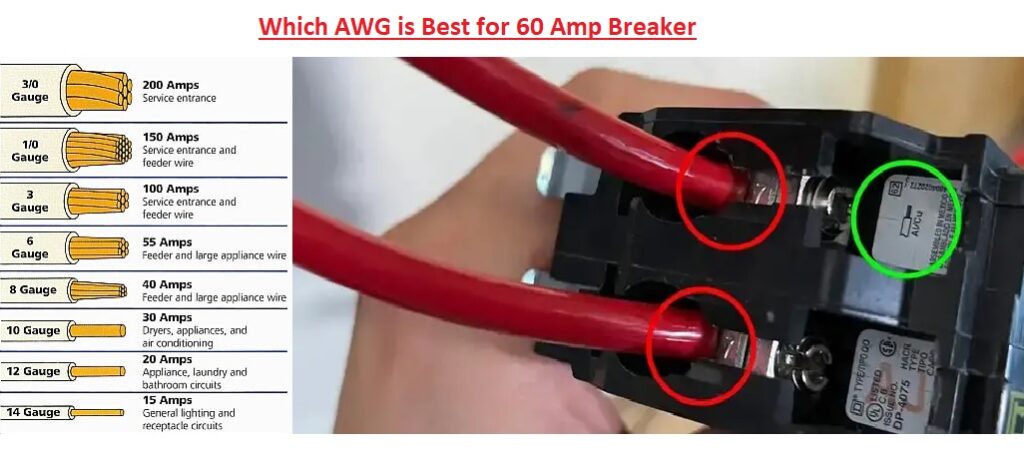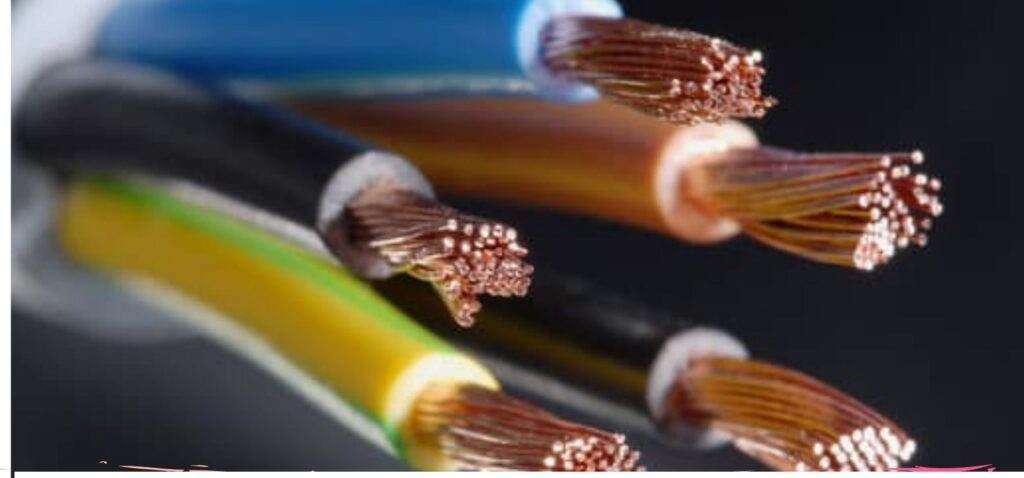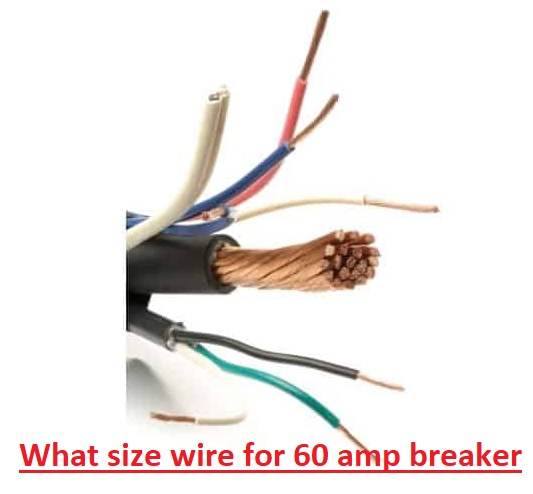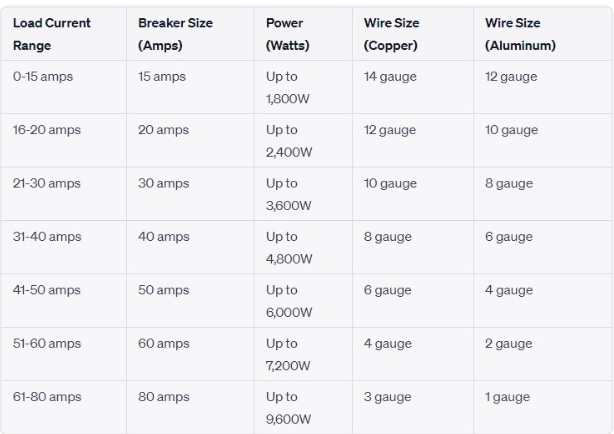Hello, readers welcome to the new post. In this post, we will discuss 60 Amp Wire Size – Which AWG is Best for 60 Amp Breaker. To have a reliable and safe electrical system there is a need for accurate wire size to use. The high American wire gauge value for a 60 amp breaker will be covered here and learn how to use accurate wire size. So let’s get started with 60 Amp Wire Size
What is Ampacity?
- The wire can conduct an electrical current and conductor such that the wire can handle current to its ampacity value in the controlled temperature rating. The unit of ampacity is amperes and its value is based on the size of wire insulation used, installation conditions, and ambient temperature
- To minimize the damage, overheating conditions, and causing fire it must use wire that comes with ampacity value or larger than the load connected. Based on the required ampacity and certain installation measurements, electrical code and different standards offer details about the use of accurate wire size
What is a Gauge?
- The American Wire Gauge system is called gauge used to discuss the different parameters of wire. It is the standard method to find the diameter and thickness of the wire. Every wire size comes with a certain gauge number defined by the AWG system and a small value of gauge number will have a high larger dia of the wire
- The value of the gauge number of the AWG system normally is from 0000 (4/0) and 40, where 0000 is the largest wire size and 40 is the lowest number. The dia of the wire increases with the gauge number decreases
- During account wire size is the main wire gauge that defines the wire resistance current carrying capacity and ampacity.
Importance of Choosing the Correct Wire Size for a 60 Amp Breaker
- There is a need for a proper amp breaker to minimize overheating, voltage loss, and other electrical faults, so there must be accurate wire used or a 60-amp breaker. The wire that is small in size can get heat and cause damage to insulation and fire.
- If the wire used is oversized can increase the cost of material and the system so use wire that is effective for the system and must save

American Wire Gauge (AWG) System
- There is the numerical number for wire size according to the AWG system, less number means the wire is thick. The 6AWG wire is thicker than the 10 AWG wire. The ampacity and current carrying features increase with wire sizes decrease
Related: What Size Wire Do I Need for a 60 Amp Sub Panel?
80% Breaker Rating Rule
- In the electrical system, there is an 80% breaker rating rule that is also called the 80 percent loading rule or the 125 percent rule. It means that the continuous load of circuitry can’t be larger than eighty percent of breaker-rated capacity.
- For a 60-amp circuit breaker, the continuous load must not be larger than 48 amps. Following the safety rules and minimizing the chances of overheating and circuit damage these rules save circuits to have continuous working at their highest capacity.
- it is good to have more than eighty percent rule work on the continuous loads that are working for about three hours or more. The eighty percent rule did not apply to motor starting current, intermittent load, or short-duration loads.
Wire Size Options for 60 Amp Breaker
- 6 AWG Wire:
- 6 AWG wire size used for 60 amp circuits.
- The ampacity rating is about 65 amps.
- Applications: For a 60 amp breaker, 6 AWG wire is the best option for differnt homes and lighting commercial applications.
- 4 AWG Wire:
- 4 AWG wire has high ampacity which means this wire is thicker than 6 AWG.
- The ampacity rating is 85 amps.
- Applications: To power transmission for larger distances it is used since it can manage voltage loss
- 3 AWG Wire:
- The thickness of 3 AWG wire is larger than 6 AWG and 4 AWG, so it carries a higher current
- ampacity rating of about 100 amps.
- Applications: it is used for applications where load increases are need
- 2 AWG Wire:
- it provides a higher ampacity and thickness.
- Ampacity: ampacity rating 115 amps.
- Applications: It uses higher electrical loads,
What Size Wire For a 60 Amp Breaker?
Normally 4AWG or 3AWG wire is used for a 60 amp circuit breaker. The ampacity of 4AWG copper wire is 85 ampere for 75 centigrade. 4 Gague wire can handle high loads at the same temperature.
It causes high voltage loss if there is a 6 gauge wire used. Mostly electrical devices used do not get 60 amps. it can reach about 50 amps, so a 6 gauge wire can work well.
Factors to Consider When Selecting Wire Size
- Distance and Voltage Drop:
- There is voltage loss that exists in longer wires, which affects the working device connected. For large losses large wire sizes used
- Wire Material:
- The commonly used materials for electricity are copper and aluminum. Mostly copper is used due to good conductivity.
- Type of Circuit:
- The size of the wire size can be affected by various circuit types, like lighting or motor circuits.
- Ambient Temperature:
- The ampacity can be reduced with temperature increases. So make sure that the wire size used has such a structure to handle the temperature conditions
Wire Size Chart and Ampacity Ratings
| Wire Size (AWG) | Diameter (inches) | Diameter (mm) | Ampacity Rating |
|---|---|---|---|
| 14 | 0.0641 | 1.628 | 15 |
| 12 | 0.0808 | 2.053 | 20 |
| 10 | 0.1019 | 2.588 | 30 |
| 8 | 0.1285 | 3.264 | 40 |
| 6 | 0.162 | 4.115 | 55 |
| 4 | 0.204 | 5.189 | 70 |
| 2 | 0.258 | 6.553 | 95 |
| 1 | 0.289 | 7.348 | 110 |
| 1/0 | 0.325 | 8.252 | 125 |
| 2/0 | 0.365 | 9.271 | 145 |
| 3/0 | 0.410 | 10.413 | 165 |
| 4/0 | 0.460 | 11.684 | 195 |
Installation Tips for 60 Amp Wire Size
- Wire Termination:
- To have a proper connection there must be a proper wire termination technique used for example terminal blocks or wire nuts.
- Proper Insulation:
- There must be proper insulation applied to avoid the connection of different compost and electrical surfaces
- Grounding and Bonding:
- There must be proper grounding and regulation techniques used to avoid electrical shock
Related: 125 Amp Wire Size and Breaker Guide
wire sizes of 60 amps for Single phases
| Single phase 120V | ||
| Distance (in feet) | Copper wire | Aluminum wire |
| 50 ft | 4 AWG | 3 AWG |
| 75 ft | 4 AWG | 3 AWG |
| 100 ft | 4 AWG | 2 AWG |
| 200 ft | 1 AWG | 2/0 AWG |
| 250 ft | 1/0 AWG | 3/0 AWG |
| 300 ft | 2/0 AWG | 4/0 AWG |
| Single phase 240V | ||
| Distance (in feet) | Copper wire | Aluminum wire |
| 50 ft | 4 AWG | 3 AWG |
| 75 ft | 4 AWG | 3 AWG |
| 100 ft | 4 AWG | 3 AWG |
| 200 ft | 4 AWG | 2 AWG |
| 250 ft | 3 AWG | 1 AWG |
| 300 ft | 2 AWG | 1/0 AWG |
| Single phase 480V | ||
| Distance (in feet) | Copper wire | Aluminum wire |
| 50 ft | 4 AWG | 3 AWG |
| 75 ft | 4 AWG | 3 AWG |
| 100 ft | 4 AWG | 3 AWG |
| 200 ft | 4 AWG | 3 AWG |
| 250 ft | 4 AWG | 3 AWG |
| 300 ft | 4 AWG | 3 AWG |
What Size Wire for 60 Amp Breaker
For a 60 amp breaker normally the 4AWG wire size is best to use. Wire gauge is the main factor for using the wire size. Normally 6AWg wire is used for a 60 amp breaker as 6AWg wire has 65 amper ampacity. and can easily handle overloading con conditions.
What Wire Size is Good for 60 Amps?

- The wire size selected for a 60 amp electrical circuit based on conductor type (copper or aluminum), wire distance, and temperature
- Normally 6 AWG is used wire gauge for a 60 amp circuitry for a copper conductor home wiring.
- There can be a large wire size used to handle voltage loss or manage the high-temperature rating if the wire is connected to longer distances or it has a high ambient temperature that is larger than the normal value
Is 10 Gauge Wire Good for 60 Amps?
- No, a 60 amp circuit, does not use a 10 gauge wire. the required wire size for a 60 amp circuit is 6 AWG to 4 AWG.
Wire Size for 60 Amp Breaker
- At homes or commercial applications, the wire size of a 60 amp circuit breaker can be 6 AWG for copper conductors.
read also: What Size of Wire Do I Need for a 100 Amp Sub Panel?
60 Amp Wire Size Chart
| Wire Size (AWG) | Copper Wire Diameter (inches) | Copper Wire Diameter (mm) | Aluminum Wire Diameter (inches) | Aluminum Wire Diameter (mm) | Ampacity (Approx.) |
|---|---|---|---|---|---|
| 6 | 0.162 | 4.115 | 0.162 | 4.115 | 65 |
| 4 | 0.204 | 5.189 | 0.204 | 5.189 | 85 |
| 3 | 0.229 | 5.827 | 0.229 | 5.827 | 100 |
| 2 | 0.258 | 6.553 | 0.258 | 6.553 | 115 |
Wire Size For 60-Amp Subpanel 50, 100, or 150 Feet Away
- 50-foot distance: 4 or 6 AWG will be good for Aluminium or copper wire material
- 100-foot distance: 2 or 4 AWG is best. for Aluminium or copper wire
- 150-foot distance: for this distance use aluminum wire of 1/0 AWG or 2 AWG gauge.
For the highest voltage loss of three percent of feeders, this dia of wries gets the voltage loss factors that can be considered
What size of ground wire do you need for 60 amps?
There is a need of 8 or 6 AWG copper wires for the ground wire. The ground wire carries current in case of a short circuit. In case of a short circuit the high current moves to a low resistance path. If there is no ground wire, it will move to the body of the device. So ground wire is needed to the safe flow of current. In the case of aluminum 6 to 4 AWG wire.
50 Amp Breaker vs. 60 Amp Breaker Applications
| Feature | 50 Amp Breaker | 60 Amp Breaker |
|---|---|---|
| Amperage | 50 amps | 60 amps |
| Circuit protection | 6 AWG wire protection | 4 AWG wire protection |
| applications | Electric ranges, ovens, hot tubs, electric car chargers clothes dryers, | Commercial uses heavy-duty tools, |
| Cost | Less costly | costly |
Example Applications
Here are some examples of certain applications for 50-amp and 60-amp breakers:
- 50 amp breaker:
- Electric range and oven
- Heat pump
- Hot tub or spa
- Subpanel for a garage or workshop
- Electric Dryer
- Electric water heater
- Central air conditioning unit
- 60 amp breaker:
- Commercial kitchen appliances like ovens, stoves, and dishwashers
- Industrial machinery
- Large workshop with multiple power tools
- High-capacity electric ovens and ranges
- Level 2 EV charging station
- Garage or workshop, like a table saw, welder, and air compressor
Breaker Size Chart
Types of Cables Used for 60 Amp Breakers
| Cable Type | Material | Gauge | Ampacity | Insulation Type | Common Applications |
|---|---|---|---|---|---|
| THHN | Copper | 6 AWG | 65 amps | Thermoplastic high heat-resistant nylon | commercial wiring |
| THHN | Aluminum | 4 AWG | 70 amps | Thermoplastic high heat-resistant nylon | home wiring |
| XHHW | Copper | 6 AWG | 65 amps | Cross-linked polyethylene (XLPE) | home and commercial wiring, outdoor and wet areas |
| XHHW | Aluminum | 4 AWG | 70 amps | Cross-linked polyethylene (XLPE) | Residential and commercial wiring, outdoor and wet places |
| MC (Metal Clad) | Copper | 6 AWG | 65 amps | Metal sheath with thermoplastic insulation | Commercial and industrial wiring system |
| MC (Metal Clad) | Aluminum | 4 AWG | 70 amps | Metal sheath with thermoplastic insulation | Commercial buildings |
Why Size Wire is Important for Breakers
The wire size is important for breakers since it explains how much current it can handle safely. If ire is small size for amper of breaker it will overheat and cause fire
Breakers are created to trip current flowing in the breaker larger than their rating. It is used to protect the wiring of the system from overheating and burn the decies. But if the wire is very small for breaker amperage, it will overheat and cause fire before the breaker trip
The following are some of the consequences of using a wire that is small for the breaker amperage:
- Overheating: The wire gets overheated and causes fire hazards.
- Voltage drop: The wire cannot carry enough current without voltage loss. It can damage the devices
- Fire: The wire can get fire if it overheats.
60 Amp Wire Size – Which AWG is Best for 60 Amp Breaker
The use of an accurate erie size of 60 amp breaker is important to have good operating and electrical safety. The selection of accurate wire size must consider the distance, type of wire ambient temperature, and distance the wire is connected.
. The safety electrical system will be improved with the use of a proper installation process and the following the electrical rules.
wire size for 60 amp sub panel 100 feet away
To find the wire size required for operating 60a wire size loads for a distance of 100 feet, follow the AWG system. Normally for 60 amp circuit 6 AWG wire size is used for copper wiring.
what size wire for 60 amp
The write size for 60 amps 12 vols is four to six AWG based on the voltage losses these wire sizes used.
What is 60 amp wire size mm
1.5 mm² or 16 AWG wire used for 60 Amps
wire size for 60 amp 220v
For 60 amps #6 wire is good to use
Wire size for 60 amp sub panel 50 feet away
To run 60 amp wire 50 to 60 feet from the main panel use 6AWG wire size. This wire can easily handle distances up to 50 feet.
Would 6-2 Romex be best for handling a 60-amp load?
It is not good to handle a 60-amp load. The NEC said that wire is best for 80 percent of load rating ampere. So wire should handle 48 amperes to get a 60 ampere rating. The 6-2 Romex wire comes with a maximum rating of 55 amperes and has features to handle 44 amperages at maximum.
Is it safe to use a larger wire size for a 60-amp circuit?
The larger wire size as compared to the permitted level causes high resistance and causes complications. So the use of 4AWG wire for a 60 amp circuit is good.
Can 6 gauge wire handle 60 amps?
The ampacity of the wire decreases if the cable is connected with another cable or configured in high ambient temperatures. But the normal ampacity of 6AWG copper wire for many circuits is 55 to 65 amperes. It can handle 55, amps, 60 amps, and 65 amps
Is number 8 wire good for 60 amps?
The wire of the # 8 gauge is only good for 50 amps.
Can 8, 6, and 10 gauge wire handle 60 amps?
These wire sizes are not good for 60-amp circuits. The electrical circuit that handles 60 amp normally needs a wire size of 6 AWG for copper conductors
What wire do I need for a 60-amp sub-panel?
For a 60 amp sub pane use about 6 AWG copper wire or 4 AWG aluminum wire. With that, there is a need to consider wire size for grounding and neutral conductors also the distance between the main panel and the sub-panel.
What gauge wire for 220v 60 amp?
For 220 volt 60 amp circuits use about 6 AWG copper wire or 4 AWG aluminum wire for live wires. Neutral and ground conductors also have this size.
Read Also:
- What Size Wire for 200 AMP Service Underground
- Types And Applications Of Titanium Wires 2023 Detailed Guide
- What Size Wire Should I Use for a 50 Amp Sub Panel?
- What is 10/3 Romex Wire Used For
- 30 Amp Wire Size: What AWG Wire You Need?
- 125 Amp Wire Size and Breaker Guide
- What Size Wire for 200 AMP Service Underground
- What Size Wire Do I Need for a 60 Amp Sub Panel?
FAQs
-
Can we use a smaller wire size for a 60-amp breaker?
- it is not preferred to use wire that is less than wire size used for the 60 amp breaker. Small wires get overheated and get damaged
-
What are the consequences of using an oversized wire for a 60 amp breaker?
- Larger wire can increase the expense without having any special advantages. So use wire tha is according to ampacity specifications.
-
Can we use aluminum wire for a 60-amp breaker?
- Yes, aluminum wire can be used for 60 amper breaker instead of copper It has good conductivity and less resistance,
-
How do we determine the correct wire size for a long distance?
- Voltage losses are considered during the selection of large wires to consider potential voltage drops.
-
Is it necessary to hire an electrician to install a 60 amp wire?
- it is recommended to hire a technician for the installation of 60 amp wire to avoid any damage
-
What size wire for 50 amps?
- 4 AWG aluminum wire or 6 AWG copper wire
-
What size wire for 80 amps?
- 2 AWG aluminum wire 4 AWG copper
-
What size wire for 100 amps?
- 0 AWG aluminum wire 2 AWG copper wire
-
What size wire for 40 amps?
- 6 AWG aluminum wire or 8 AWG copper wire
-
What gauge wire for 50 amp 220v?
- 4 AWG aluminum wire or 6 AWG copper wire
-
What size wire for 50 amp vs 60 amp?
- The similar size wire can be used for both 50 amp and 60 amp circuits, as wire size is selected on the basis of the ampacity of the breaker
-
What size wire for 70 amps?
- 1 AWG aluminum wire or 3 AWG copper wire
-
What size wire for 75 amps?
- 0 AWG aluminum wire or 2 AWG copper wire
-
What does 60 amp wire look like?
- 60 amp wire is solid copper wire with black insulation.
-
What size wire for 42 amps?
- 6 AWG aluminum wire or 8 AWG copper wire or
-
What size wire for 30 amps?
- 8 AWG aluminum wire or 10 AWG copper wire or
- What size wire for 45 amps?
-
A 6 AWG copper wire or 4 AWG aluminum wire is the least wire size used for 45 amp circuit.
- What is a 60 amp used for?
-
A 60-amp breaker is normally used for electric stoves, electric dryers, and electric ovens that use large power.
- Is 60 amps good?
60 amps is a good to use at some homes. It can provide power to devices without overloading the circuit. However, if you have high-power appliances, we use a higher amperage breaker.
- What size cable do I need for 63 amps?
A 4 AWG copper cable is the minimum wire size of a 63 amp circuit and for 2 AWG aluminum cable
- What size is 40 amp wire in MM?
A 40 amp wire is 6.35 mm in diameter.
- What size wire for 48 amps?
wire size needed for a 48 amp circuit is6 AWG copper wire or 4 AWG aluminum wire
- How many amps is 10 watts?
The amps is equal to the watts divided by the voltage. So, 10 watts divided by 120 volts is 0.083 amps.
- What is a wire gauge in MM?
The wire gauges the thickness of the wire. The small wire gauge wire will be high thickness So, a 10 AWG wire is thicker than a 12 AWG wire.
- What is wire size by number?
American Wire Gauge (AWG) number is The wire size. The less the AWG number, the wire will be thick So, a 6 AWG wire is thicker than an 8 AWG wire.
- What size wire for 50 amps at 100 feet?
A 6 AWG copper wire wire size is used for a 50 amp circuit with a 100-foot run.
- What gauge wire for 60 amp 240v?
A 4 AWG copper wire or 3 AWG aluminum wire is the minimum wire size for a 60 amp 240v circuit.
- What size wire for 70 amps at 100 feet?
for a 70 amp circuit with a 100-foot run. the wire is size is A 3 AWG copper wire or 1 AWG aluminum wire
- What size wire for 32 amps?
the wire size for a 32 amp circuit is 10 AWG copper wire or 8 AWG aluminum
- How much current can 240 sqmm copper cable carry?
A 240 sqmm copper cable can carry 100 amps of current.
- What amp is required for 240v?
The amp was used for 240v on the basis of the load. Normal household appliances need 15-20 amps of current. some devices like electric dryers and electric ovens, use 50 amps of current.
- What size wire for 100 amps at 200 feet?
for a 100 amp circuit with a 200-foot run, 2 AWG copper wire or 0 AWG aluminum wire is the wire size needed
- What size wire is 100 amps in feet?
100 amps wire size based on the length of the run. For a smaller run, a 4 AWG copper wire is good. However, for a longer run, a higher wire size can be used.
- What size wire for 200 amps?
the wire size for a 200 amp circuit is 0 AWG copper wire or 4/0 AWG aluminum.
- What size wire for 20 amps at 75 feet?
12 AWG copper wire or 10 AWG aluminum wire is the wire size used for a 20 amp circuit with a 75-foot run.
- What size wire for 15 amps at 100 feet?
14 AWG copper wire or 12 AWG aluminum wire is the minimum wire size
- What size wire for 20 amps at 100 feet?
12 AWG copper wire or 10 AWG aluminum wire is wire size.










For a 60 amp circuit, you should use a wire size that can safely carry that amount of current without overheating. The American Wire Gauge (AWG) system is used to specify wire sizes, and the appropriate wire size for a 60 amp breaker is typically AWG 6 copper wire.